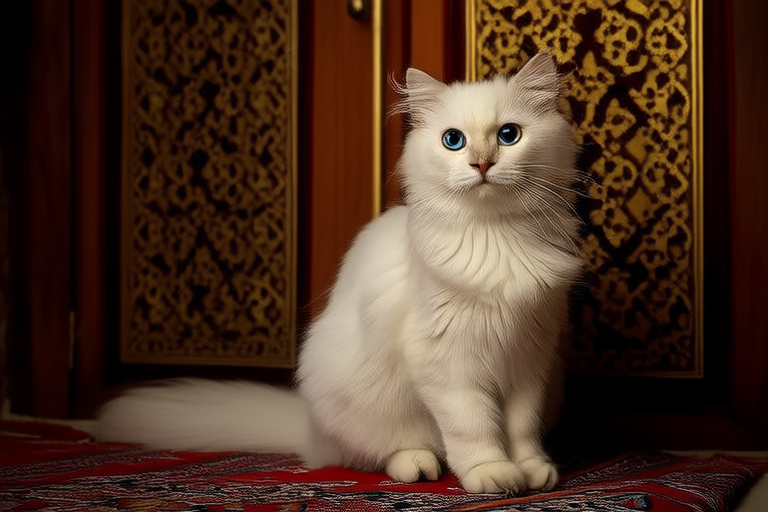From Ottoman Palaces to Modern Homes: The Timeless Charm of Turkish Angoras
In the heart of the bustling streets of Istanbul, the legacy of the Ottoman Empire lives on through various cultural artifacts and traditions. Among these treasures are the Turkish Angora cats, whose history is deeply intertwined with the opulent palaces and grandeur of the Ottoman era. These felines have been cherished for centuries, not only for their beauty but also for their unique traits that made them indispensable companions. This article explores the historical significance of Turkish Angoras in Ottoman culture, their transition from grand historical settings to contemporary households, and their enduring appeal as beloved pets.
The Historical Significance of Turkish Angoras in Ottoman Culture
The Turkish Angora, named after Ankara (formerly known as Angora), has a rich history dating back to the Ottoman Empire. In the royal courts of the sultans, these cats were more than just pets; they were symbols of luxury and prestige. Their presence in the palaces was not merely ornamental but practical as well. Turkish Angoras were adept at controlling rodent populations, ensuring the safety and cleanliness of the royal residences. They were also highly valued for their beauty and grace, often being gifted to foreign dignitaries as tokens of goodwill.
One of the most famous stories involving Turkish Angoras in Ottoman history is that of the Sultan’s cat, Muezza. According to legend, one day while the Sultan was resting, his cat lay on his sleeve. When called upon to lead prayers, the Sultan found it impossible to move without disturbing the cat. Instead, he cut off the sleeve of his robe, much to the admiration of those around him. This anecdote underscores the high regard in which these cats were held within the Ottoman court.
The Physical Characteristics of Turkish Angoras
Turkish Angoras are renowned for their elegant appearance, which includes a silky, snow-white coat and striking blue eyes. Their slender yet muscular build makes them agile and graceful, perfectly suited to their environment. The white fur is particularly prized, and it is said that the first Turkish Angoras were given as gifts to European royalty, who marveled at their purity and beauty.
These cats have a medium-length body with a fine bone structure, giving them a delicate yet strong presence. Their tails are long and plumed, adding to their regal demeanor. The blue eyes, which are often described as mesmerizing, are a result of a genetic mutation that causes albinism. This genetic trait, combined with their striking appearance, has made Turkish Angoras a favorite among cat enthusiasts and breeders alike.
The Adaptability of Turkish Angoras
Despite their origins in the grand palaces of the Ottoman Empire, Turkish Angoras have seamlessly adapted to modern homes, maintaining their popularity among cat lovers worldwide. Their intelligence and playful nature make them excellent companions for families and individuals alike. These cats are known for their curiosity and affectionate behavior, often forming strong bonds with their owners.
Turkish Angoras are highly adaptable to different living environments, from large apartments to spacious houses. They thrive in environments where they can explore and play, often engaging in interactive games with their owners. Their playful demeanor is complemented by a quiet and calm temperament, making them ideal for both active and laid-back households. They are also known for their loyalty and can be quite vocal when seeking attention or expressing their needs.
Anecdotes and Stories About Famous Turkish Angoras
Throughout history, Turkish Angoras have been the subject of numerous stories and legends. One such tale involves a Turkish Angora named Luna, who became a celebrity in her own right. Luna was adopted by a family in New York City and quickly gained fame for her stunning appearance and engaging personality. She even appeared in several cat shows, winning numerous awards for her elegance and poise.
Another story revolves around a Turkish Angora named Sultan, who was known for his exceptional agility and intelligence. Sultan was adopted by a family in London and quickly became the center of attention. His ability to open doors and cabinets amazed his owners, who often found him perched on counters or shelves, surveying his domain. Sultan’s antics became legendary, and he was often featured in local newspapers and magazines.
The Enduring Appeal of Turkish Angoras
The enduring appeal of Turkish Angoras lies in their timeless charm and adaptability. As symbols of Turkish heritage, these cats continue to captivate cat lovers worldwide. Their beauty, intelligence, and playful nature make them ideal companions for those seeking a loving and loyal pet. Despite their illustrious past, Turkish Angoras remain accessible to cat enthusiasts, with many breeders working tirelessly to preserve the breed’s unique characteristics.
The preservation of Turkish Angoras as a symbol of Turkish heritage is crucial, as it ensures that future generations will have the opportunity to experience the joy and companionship that these cats provide. By continuing to support and promote the breed, we can ensure that the legacy of the Ottoman Empire lives on through the gentle and elegant Turkish Angora.
In conclusion, the journey of Turkish Angoras from Ottoman palaces to modern homes is a testament to their enduring charm and adaptability. Their history is rich with tales of luxury, prestige, and companionship, making them a beloved part of Turkish culture and a cherished addition to many households around the world. Whether you are a history enthusiast or a cat lover, the Turkish Angora offers a unique blend of elegance, intelligence, and companionship that continues to captivate hearts and minds.
